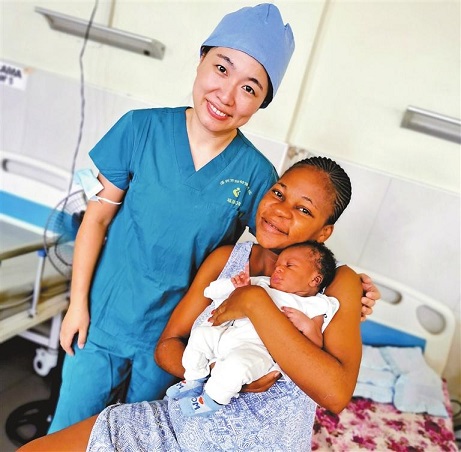Shenzhen
 2024/2/7
2024/2/7
 source: Shenzhen Daily
source: Shenzhen Daily
 Print
Print

Gao Hang (L), a doctor from Shenzhen, poses for a photo with a mother and her baby, the first newborn Gao has delivered since she arrived at Equatorial Guinea in December last year as a member of a Shenzhen medical team on an aid mission in the country. Courtesy of the Shenzhen medical team
Editor’s Note:
Over the past decade, Shenzhen has enthusiastically engaged in deepening exchanges and collaborations in areas such as infrastructure connectivity, trade facilitation, financial integration, and people-to-people bonds with Belt and Road countries. Shenzhen Daily is presenting a series of reports on the city’s active role in boosting the high-quality development of the Belt and Road Initiative.
Zhang Yu
JeniZhang13@163.com
AFTER more than 20 hours of travel, the 33rd Chinese medical team sent to assist Equatorial Guinea arrived in the Central African country Dec. 3, 2023. China has dispatched medical teams to Equatorial Guinea since 1971.
This is the first time that Shenzhen has independently formed a foreign aid medical team, with all members hailing from 12 Shenzhen hospitals.
The team arrived with a supply of medicines and medical consumables worth millions of yuan, which were donated by China.
Shenzhen’s engagement with global health-related issues is expanding in scope and breadth because of the Belt and Road Initiative (BRI) and the Health Silk Road. The city’s aid to Belt and Road partner countries, and the experience it has shared with them, render the Health Silk Road more concrete.
SZ’s 1st foreign
aid medical team
Over the next year and a half, the Shenzhen team will provide health care services for, and carry out academic exchanges and cooperation with, the country.
According to the team’s leader Tian Huaigu, director of the Quality Control Department at Peking University Shenzhen Hospital, the team consists of 25 people, including support-staff like translators and chefs. The team’s doctors are all attending doctors or of a higher rank, and 75% are chief physicians, deputy chief physicians, and chief caregivers.
Team members were assigned to different posts, with 12 at the regional hospital in Malabo, the capital of Equatorial Guinea, nine at the regional hospital in Bata, the country’s second -largest city, and four at other locations.
On the initial workday of 2024, the medical team faced a demanding anesthesia case: a middle-aged woman with a large thyroid mass requiring surgical removal and experiencing breathing complications.
Before the surgery, Chen Zhicong, an anesthesiologist from the Second People’s Hospital of Shenzhen stationed in the Regional Hospital of Malabo, discovered that apart from a visual laryngoscope brought by the Chinese medical team, there were no other tools for the surgery in the hospital.
Chen and Dr. Galo, the only doctor in the hospital’s anesthesia department, developed a meticulous plan to overcome the challenges and successfully removed a tumor larger than a fist.
The surgeons were overjoyed and surrounded Chen, asking: Is the visual laryngoscope produced in China? Is it expensive? Can you teach us? Chen replied: “It’s made in China. Although it’s expensive, we brought it over hoping to help you master the use of this device.”
Chen also purchased a batch of lumbar puncture needles at his own expense, which were brought from China to Equatorial Guinea and provided free of charge to patients unable to afford the cost.
Liu Anwen, also a surgeon from the Second People’s Hospital of Shenzhen, brought laparoscopic training equipment he had personally purchased to train local doctors in Equatorial Guinea.
Tian recalled that on the first day of arriving in Malabo, he was walking on the road when an old man warmly greeted him and asked if he was a Chinese doctor. After receiving an affirmative reply, the old man said: “Médicos chinos son muy buenos [Chinese doctors are very good].”
The old man pointed to his stomach and explained that his surgery was done by a Chinese doctor, and he is now very healthy.
Medical
cooperation
The Health Silk Road of the BRI aims to enhance public health and foster international cooperation in the health care sector.
The Shenzhen Municipal Health Commission has actively participated in international medical cooperation.
In Nov. 2019, Shenzhen Luohu People’s Hospital welcomed a special group of guests — a delegation composed of presidents and experts from 15 key hospitals in Kazakhstan that hoped to learn from the city’s medical reform experience.
In recent years, traditional Chinese medicine (TCM) experts in Shenzhen have traveled to Belt and Road partner countries to carry out trainings.
According to statistics, several African countries including Algeria, Zambia, Ethiopia, Tunisia, and Egypt, and some regional organizations, have visited the Beijing University of Chinese Medicine Shenzhen Hospital for exchanges and learning.
Kazakhstan’s Ministry of Healthcare and Shenzhen’s Luohu Hospital Group have signed a framework agreement to jointly build a Sino-Kazakhstan telemedicine exchange platform that will serve as a clinical and academic exchange platform for medical experts from both sides.





